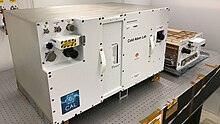Cold Atom Laboratory

The Cold Atom Laboratory (CAL) is an experimental instrument on board the ISS, which launched in 2018. It creates an extremely cold microgravity environment in order to study behaviour of atoms in these conditions.[1][2]
Timeline[]
The CAL was developed at JPL in Pasadena, California.[3] It was originally scheduled for launch to the International Space Station (ISS) in June 2017.[4] It was then delayed until a scheduled launch on a SpaceX CRS-12 rocket in August 2017.[5] It was finally launched on May 21, 2018.[2] The initial mission had a duration of 12 months with up to five years of extended operation.[4]
In January 2020 it underwent hardware upgrades, which were carried out over an eight-day period by astronauts Christina Koch and Jessica Meir under the supervision of ground controllers.[1] The upgrade included an atom interferometer which can be used to study the equivalence principle.[6]
In July 2021, another upgrade by astronaut Megan McArthur gave CAL the ability to work with ultracold potassium atoms in addition to rubidium atoms.[7]

Purpose[]
The instrument creates extremely cold conditions in the microgravity environment of the ISS, leading to the formation of Bose Einstein Condensates (BECs) that are a magnitude colder than those that are created in laboratories on Earth.[4] In a space-based laboratory, up to 10 seconds interaction times and as low as 1 picokelvin temperatures are achievable, and it could lead to exploration of unknown quantum mechanical phenomena and test some of the most fundamental laws of physics.[8][4] These experiments are best done in a freely falling environment, because it is more conducive to uninhibited formation of BECs. Ground based experiments suffer from the effect of the condensate interacting asymmetrically with the apparatus, interfering with the time evolution of the condensate. In orbit, experiments can last much longer because freefall is sustained indefinitely.[4] NASA's JPL scientists state that the CAL investigation could advance knowledge in the development of extremely sensitive quantum detectors, which could be used for monitoring the gravity of Earth and other planetary bodies, or for building advanced navigation devices.[4]
Results[]
The results of the experiments from 2019 were reported in 2020, demonstrating successful operation of the laboratory. This enables improved research of BECs and quantum mechanics, since physics are scaled to macroscopic scales in BECs. The lab supports long-term investigations of few-body physics, and supports the development of techniques for atom-wave interferometry and atom lasers.[9][10][11]
See also[]
References[]
- ^ a b "The Space Station's Coolest Experiment Gets Astronaut-Assisted Upgrade". NASA/JPL. Retrieved 2020-09-13.
- ^ a b "NASA is creating a super cold lab in space to study quantum physics/". QUARTZ. 2018-05-24. Retrieved 2018-05-24.
- ^ Elizabeth, Landau (2016-03-18). "Cold Atom Laboratory Doing Cool Research". NASA. Retrieved 2020-11-19.
- ^ a b c d e f "Cold Atom Laboratory". coldatomlab.jpl.nasa.gov. Retrieved 2019-08-29.
- ^ "NASA to launch Cold Atom Lab in space".
- ^ Green, Jim; Elliot, Ethan (2021-08-06). "Season 5, Episode 13: Freaky Physics on the Space Station". NASA Gravity Assist. Retrieved 2022-01-25.
- ^ "Upgrading the Space Station's Cold Atom Lab With Mixed Reality". coldatomlab.jpl.nasa.gov. 2021-10-26. Retrieved 2022-01-23.
- ^ "Cold Atom Laboratory Creates Atomic Dance". NASA News. 26 September 2014. Retrieved 2015-05-21.
- ^ Lachmann, Maike D.; Rasel, Ernst M. (June 2020). "Quantum matter orbits Earth". Nature. pp. 186–187. doi:10.1038/d41586-020-01653-6. Retrieved 4 July 2020.
- ^ "Quantum 'fifth state of matter' observed in space for first time". phys.org. Retrieved 4 July 2020.
- ^ Aveline, David C.; Williams, Jason R.; Elliott, Ethan R.; Dutenhoffer, Chelsea; Kellogg, James R.; Kohel, James M.; Lay, Norman E.; Oudrhiri, Kamal; Shotwell, Robert F.; Yu, Nan; Thompson, Robert J. (June 2020). "Observation of Bose–Einstein condensates in an Earth-orbiting research lab". Nature. 582 (7811): 193–197. doi:10.1038/s41586-020-2346-1. ISSN 1476-4687. Retrieved 4 July 2020.
External links[]
 Media related to Cold Atom Laboratory at Wikimedia Commons
Media related to Cold Atom Laboratory at Wikimedia Commons- Cold Atom Laboratory – Project web site at JPL
- Bose–Einstein condensates
- Space science experiments
- International Space Station experiments
- Quantum physics stubs